Originally published on April 10, 2018, updated March 4, 2025
Menu
Join Our Email List
- Receive our monthly newsletter.
- Stay up to date on Amazon policies.
- Get tips to grow your business.
Amazon buyers rate their experiences buying from you by leaving a seller feedback rating. As an Amazon seller, it's likely that you know that seller feedback is an important metric that can impact your account health and ability to win the Buy Box.
However, you might be less familiar with Amazon feedback guidelines. Keep reading to learn about Amazon feedback policy, how and when to request feedback, and how to manage negative feedback.
Amazon uses a star rating system for seller feedback with one star as the lowest rating and five stars as the highest. Each seller’s average star rating is displayed on their Amazon seller profile.
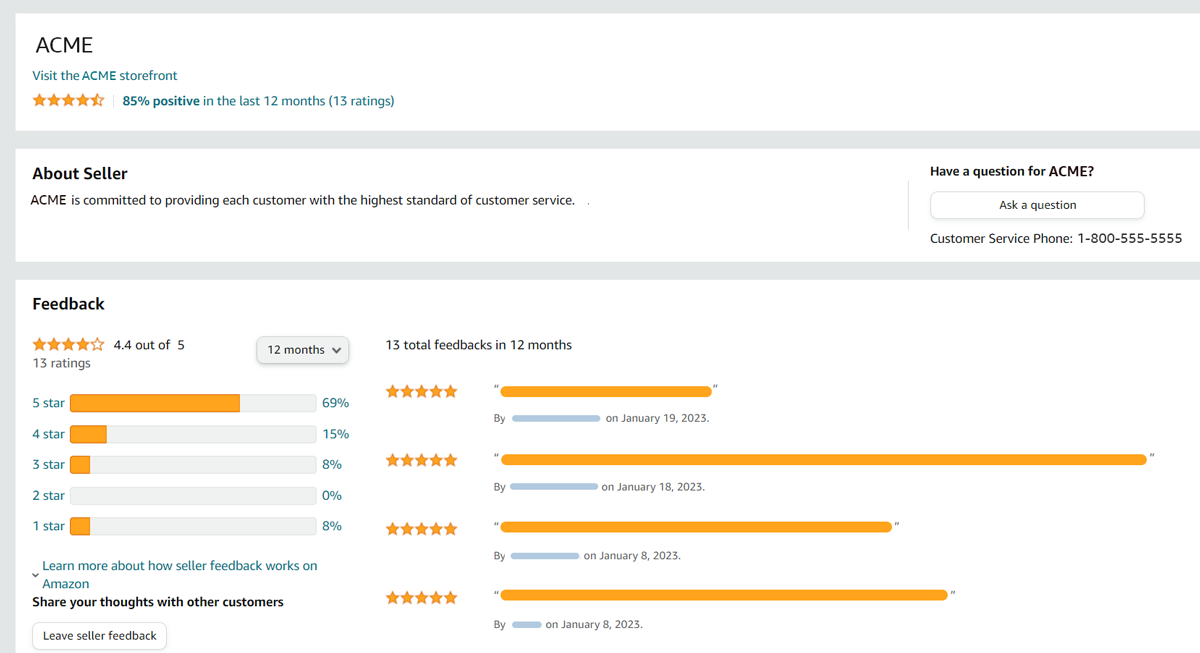
Buyers can leave feedback about their experience purchasing from your store. When leaving seller feedback, they are asked if the item was as you described it. They can also leave a comment providing more details about their buying experience.

Amazon encourages buyers to think about the following when providing seller feedback:
What about feedback that isn’t related to the buying experience or violates an Amazon guideline?
Feedback that falls into one of these categories may be removed at Amazon’s discretion. Feedback that contains obscene/abusive language, promotional content, personal information, and/or a product review could be considered for removal, according to Amazon feedback guidelines.
You can send feedback requests to buyers. In fact, it's one of the best ways to get more seller feedback. However, it’s important to be aware of Amazon’s feedback guidelines and avoid violating them. The need to have a thorough understanding of these guidelines is a responsibility no seller should take lightly. After all, no one sets out to have their account suspended, but violating Amazon’s guidelines could put your account in hot water.
The Communication Guidelines include the most important Amazon feedback guidelines you should know. Your messages to buyers can only be sent through Amazon's Request a Review message or software that connects to Amazon's API. If you go the software route, ensure it is included in Amazon's Selling Partner Appstore. While you're there, check out FeedbackFive by eComEngine, our top-rated feedback and review tool!
Need more information about requesting and managing Amazon feedback? Check out these policy pages.
We recommend getting very familiar with the Communication Guidelines, but here are the highlights related to sending feedback requests. In the policy, Amazon states that: You may send proactive Permitted Messages...requesting product review or seller feedback or both...
Proactive Permitted Messages have to be sent within 30 days of order completion and need to be in the buyer's preferred language. They also need to include the 17-digit order ID. Beyond that, there are some additional Amazon feedback guidelines to keep in mind:
Worried you might accidentally violate an Amazon policy? Check out the Amazon Feedback and Review Request Template in FeedbackFive, which allows you to schedule automation for the Amazon Request a Review messaging system. These messages are created by Amazon and cannot be edited, so you can rest assured that the wording of your request will always be 100% compliant.
Using feedback software such as FeedbackFive benefits your business in several ways. You get to skip the process of sending manual feedback requests, but you can still create a customized message for each of your products. Instead of checking for new seller feedback, you can choose to receive SMS or email alerts for new feedback. You can request negative feedback removal right from the tool (more on that below). You can also exclude refunded or out-of-country orders, and avoid sending requests for certain SKUs.
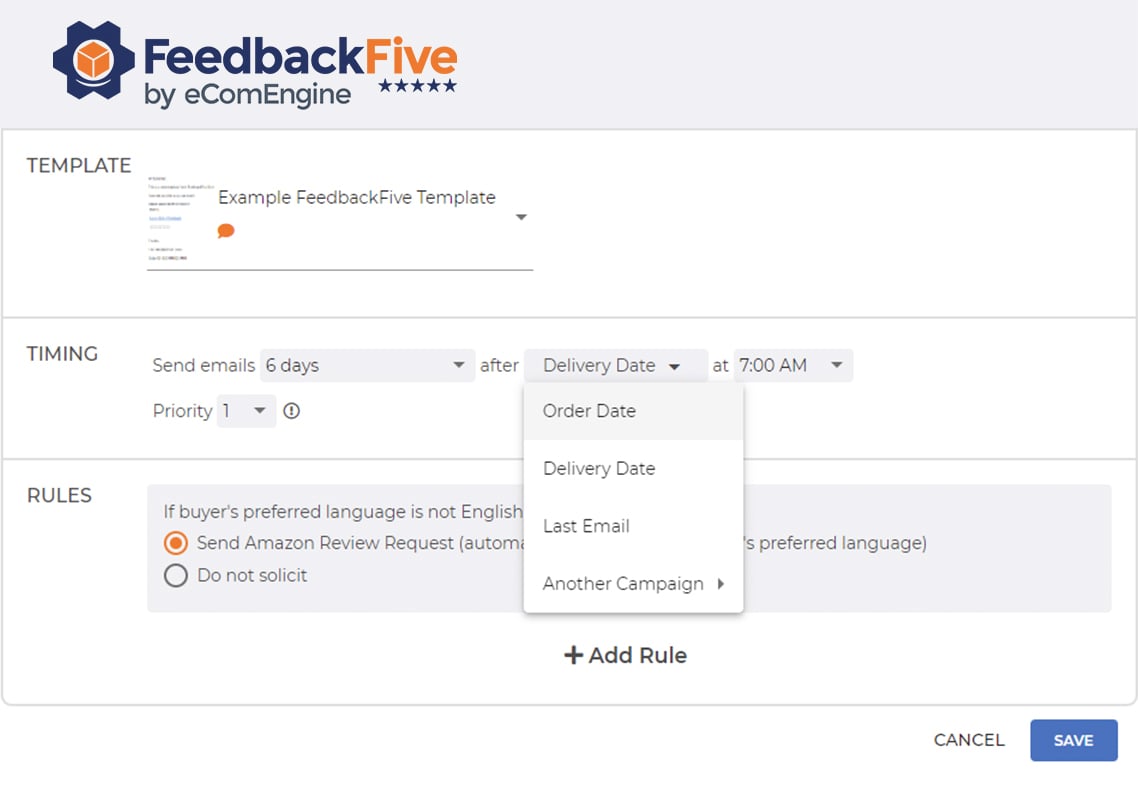
Alternatively, you can send the Request a Review message which includes a request for a product review as well as seller feedback. This works well for many sellers because it's easy to stay compliant with Amazon's feedback guidelines. However, if feedback is your main focus you may benefit from sending a specific feedback request since the review request is more prominent in the message. If you want to send a customized feedback request, FeedbackFive keeps you compliant by allowing you to substitute the Request a Review message if your buyer's preferred language is not English.
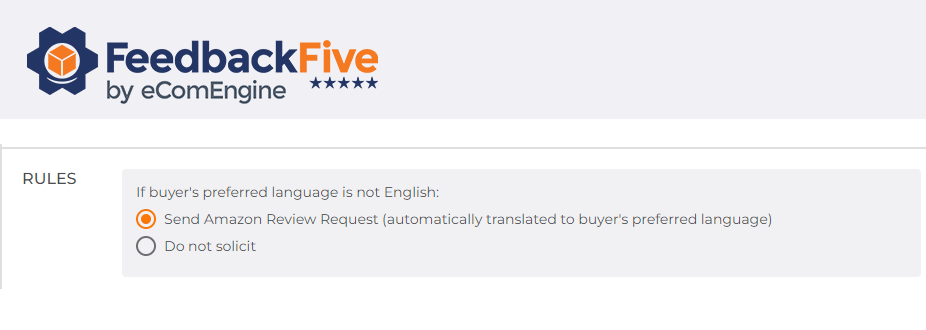
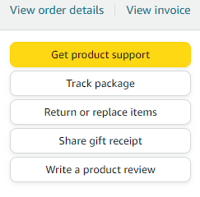 Sending a feedback request makes it much easier for buyers to leave feedback. The option to leave seller feedback isn't even available in the buyer's Amazon order history.
Sending a feedback request makes it much easier for buyers to leave feedback. The option to leave seller feedback isn't even available in the buyer's Amazon order history.
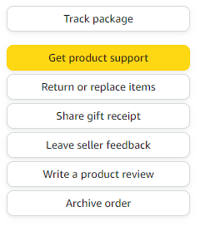 Instead, buyers need to go to their order details to click "Leave seller feedback" and rate you. Sending them a direct link simplifies this process and increases the likelihood that you'll receive feedback. It also provides a cleaner and more professional experience with your business.
Instead, buyers need to go to their order details to click "Leave seller feedback" and rate you. Sending them a direct link simplifies this process and increases the likelihood that you'll receive feedback. It also provides a cleaner and more professional experience with your business.
Your subject line is key to the success of your Amazon seller feedback request. Make sure the subject is clear and relevant to the message. If you're using FeedbackFive, you can use shortcut tags to include the name of the product or the order number in the subject line. Since 47% of email recipients open messages based on the subject line, it’s important to make sure that yours is effective.
How was your experience with [Store Name]?
Including your store name gets the recipient familiar with your brand from the get-go.
Rate Your Experience With Us
Explicitly stating the reason for the email in your subject line can lead to better open rates.
Quick question about your recent Amazon order
A short and sweet subject line can stand out in a congested inbox.
Your message should be friendly and concise. Use proper grammar and check your spelling. A message that is sloppily dashed off could make buyers see your business as unprofessional or lazy.
Avoid making buyers read between the lines to figure out what you are asking of them; be sure that your call-to-action is very clear and polite.
One well-written email can generate great results for your Amazon business. Keep your language neutral; avoid if/then statements and messaging that encourages a positive rating.
Need help getting started? FeedbackFive offers a feedback request template and our Customer Success team can help you get set up or optimize your requests. You can also check out our free Amazon feedback request template for inspiration!
You should test everything from when you send your message to what subject line you use. To do this, you can copy your templates in FeedbackFive and then change one element to see what performs best over time. For example, you could try using the same message with two different subject lines. Avoid testing more than one piece of your feedback request message at once so you’ll be able to determine exactly what is (and isn’t) working in your current messaging. The results may surprise you!
Enlist a good friend or acquaintance who will be truthful with you to read your feedback request message. Or, chat with one of our awesome Customer Success team members! Get their perspective and use their advice to hone your messaging. A well-crafted feedback solicitation message can accelerate your Amazon business, so it really is worth taking the time to make sure you’ve set it up well.
Sellers frequently ask us about the best time to send a feedback request message. While there is no definitive answer, we’re happy to share some observations. After all, we’ve helped Amazon sellers get millions of feedback since our tool was created in 2009!
Generally, it makes sense to send a seller feedback request shortly after an item is successfully delivered. Based on our discussions about email timing with users who experience better-than-average open rates, seller feedback messages sent 3-8 days after the order date are the most successful. (With Pro + plans, you can use FeedbackFive’s delivery timing rule to send your message after the item has been delivered. Otherwise, if you’re using the FBA program, you’ll probably want to send your message 5-7 days after the order date. If you’re fulfilling orders, try sending your message 2-3 days after the estimated delivery date.)
Tuesday through Friday tend to be good days to send requests, but that can vary, so feel free to experiment to find what works best for your business. Messages sent in the morning before 8:30 or around 6:00 in the evening appear to perform well for many FeedbackFive users. Don't forget that all feedback and/or review requests must be sent within 30 days of order completion per Amazon Communication Guidelines.
While most seller feedback is positive, the occasional negative feedback can really wreak havoc on your seller reputation. FeedbackFive offers text/email alerts for negative or neutral feedback to keep you informed and ready to act quickly.
Amazon customers expect the very best in customer service. After all, they have been trained to expect fast delivery, quality products, and good packaging. If a buyer leaves negative feedback, Amazon encourages you to contact the buyer to attempt to resolve the issue.
The Resolve or respond to buyer feedback page in Seller Central says:
After resolving their concerns, you can notify the buyer that it is possible to update, remove, or provide additional feedback if they wish to do so. Remember that pressuring or incentivizing a buyer to remove or modify negative feedback is a violation of our policies.
You can use the feedback removal request template in FeedbackFive to send a polite request after working with the buyer to resolve the problem. It includes the steps the buyer will need to take to edit or remove their feedback. It's worth noting that this is specific to seller feedback. You should never contact a buyer to request a change to their product review, as that is a violation of Amazon policy.
If you do happen to receive negative feedback and don't have any luck contacting the buyer, you may be able to request removal through Amazon's Feedback Manager. You can only request feedback removal if the feedback contains obscene/profane language or personally identifiable information about you, such as your email address, full name, or telephone number.
Related Reading: Negative Feedback Removal Template
If the feedback is actually a product review you can ask Amazon to remove it. However, if the rating contains feedback as well as a product review, it cannot be removed. Amazon might strike through feedback related to the fulfillment experience if the order was fulfilled by Amazon or the Buy Shipping service.
Here at eComEngine, we are committed to your success on the Amazon marketplace. If you have questions about feedback, check out our Help Center or contact our Customer Success team. We hope these Amazon feedback guidelines are helpful!
Originally published on April 10, 2018, updated March 4, 2025
This post is accurate as of the date of publication. Some features and information may have changed due to product updates or Amazon policy changes.
These Stories on Feedback and Reviews
14321 Winter Breeze Drive
Suite 121 Midlothian, VA 23113
Call us: 800-757-6840





Copyright© 2007-2025 eComEngine, LLC. All Rights Reserved. eComEngine®, FeedbackFive®, RestockPro®, and SellerPulse® are trademarks or registered trademarks of eComEngine, LLC. Amazon's trademark is used under license from Amazon.com, Inc. or its affiliates.
No Comments Yet
Let us know what you think